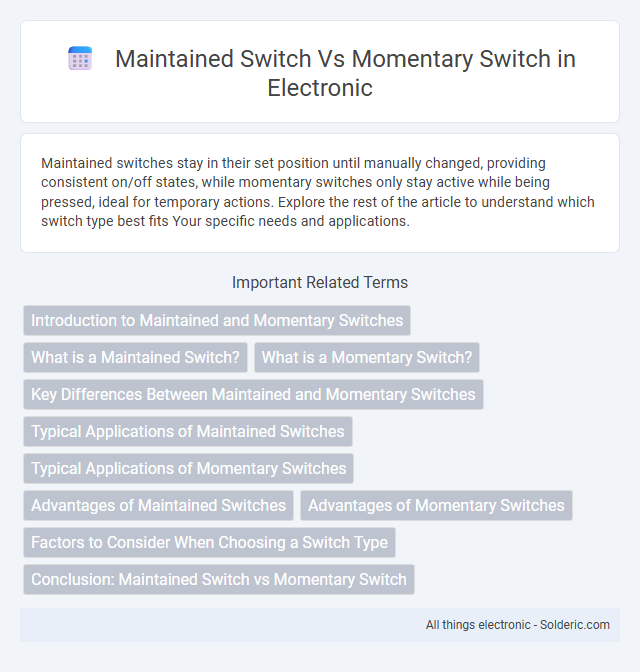Maintained switches stay in their set position until manually changed, providing consistent on/off states, while momentary switches only stay active while being pressed, ideal for temporary actions. Explore the rest of the article to understand which switch type best fits Your specific needs and applications.
Comparison Table
| Feature | Maintained Switch | Momentary Switch |
|---|---|---|
| Operation | Stays in position until manually changed | Returns to original position when released |
| Use Case | Power toggling, mode selection | Doorbells, reset buttons |
| State | Stable, latching | Temporary, momentary contact |
| Examples | Toggle switch, rocker switch | Push button, spring return switch |
| Application | Long-term control settings | Short-term triggers |
| Electrical Contact | Maintains closed/open circuit | Closes circuit only while pressed |
Introduction to Maintained and Momentary Switches
Maintained switches stay in a fixed ON or OFF position after being pressed, making them ideal for applications requiring a stable state, such as light switches or power controls. Momentary switches return to their default position when released, commonly used in devices like doorbells or keyboards for temporary activation. Your choice depends on whether you need continuous operation or brief, momentary input.
What is a Maintained Switch?
A maintained switch is a type of electrical switch that stays in its activated position after being pressed, allowing continuous flow of current until manually changed. Unlike a momentary switch, it does not return to its original state when released, making it ideal for applications requiring an ongoing connection, such as light switches or power buttons. Your choice of switch type depends on whether you need a persistent on/off state or a temporary signal.
What is a Momentary Switch?
A momentary switch is an electrical switch that only stays in its active state while being pressed, immediately returning to its original position once released. Unlike maintained switches, momentary switches are used for applications requiring temporary control, such as doorbells or keyboard keys. Your device benefits from momentary switches when brief, precise inputs are needed without long-term engagement.
Key Differences Between Maintained and Momentary Switches
Maintained switches stay in their selected position until manually changed, making them ideal for applications requiring a continuous on or off state, such as light switches or power controls. Momentary switches only remain active while being pressed, providing temporary input for functions like doorbells or keyboard keys. Understanding your device's operational needs helps determine whether a maintained or momentary switch best suits your control requirements.
Typical Applications of Maintained Switches
Maintained switches are commonly used in applications requiring a stable on/off state, such as light switches in residential and commercial buildings, power tools, and machinery control panels. These switches remain in their selected position until manually changed, making them ideal for settings that need consistent operation without repeated activation. Typical uses include controlling lighting circuits, enabling or disabling equipment, and activating appliances where persistent control is essential.
Typical Applications of Momentary Switches
Momentary switches are widely used in applications requiring temporary activation, such as computer keyboards, doorbells, and gaming controllers. These switches complete a circuit only while being pressed, making them ideal for tasks like reset buttons, elevator call buttons, and flashlights. Your devices benefit from momentary switches when precise, short-duration input is essential for operation.
Advantages of Maintained Switches
Maintained switches offer the advantage of retaining their state after being pressed, providing consistent and reliable operation in applications requiring a stable on/off condition. Your system benefits from reduced energy consumption since the switch does not need to be continuously pressed or held to maintain the circuit's status. These switches are ideal for devices like lighting controls, where long-term activation is necessary without constant user input.
Advantages of Momentary Switches
Momentary switches offer precise control by activating only when pressed, reducing the risk of accidental or continuous operation, which enhances safety and energy efficiency in your devices. Their design supports applications requiring temporary input, such as in keyboards, doorbells, and reset buttons, ensuring reliable, quick responses without mechanical wear associated with prolonged engagement. Momentary switches also facilitate enhanced system feedback and control flexibility, making them ideal for complex electronic circuits needing instantaneous activation.
Factors to Consider When Choosing a Switch Type
When choosing between a maintained switch and a momentary switch, consider the application's functional requirements, such as whether continuous ON/OFF states or temporary activation is needed. Evaluate factors like current rating, durability, environmental conditions, and user interface preferences to ensure reliability and safety. Additionally, ease of installation and maintenance, along with cost-effectiveness, play crucial roles in selecting the appropriate switch type for specific industrial or consumer electronics applications.
Conclusion: Maintained Switch vs Momentary Switch
Maintained switches stay in their set position until manually changed, making them ideal for applications requiring a consistent on/off state, such as light switches or power controls. Momentary switches only remain active while pressed, suitable for functions like doorbells or keyboard keys where temporary activation is needed. Your choice depends on whether you need a persistent or temporary signal for controlling your devices.
Maintained switch vs Momentary switch Infographic

 solderic.com
solderic.com